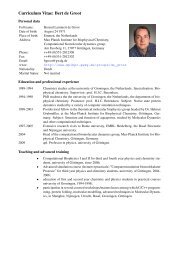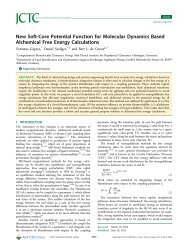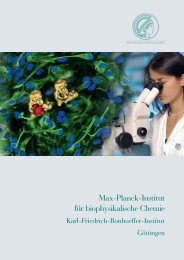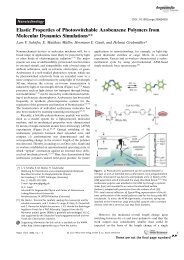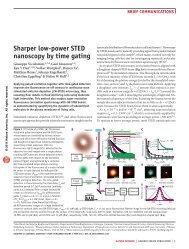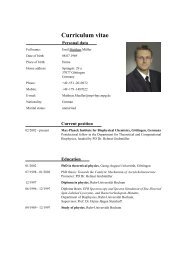Seminar for PhD students - Max-Planck-Institut für biophysikalische ...
Seminar for PhD students - Max-Planck-Institut für biophysikalische ...
Seminar for PhD students - Max-Planck-Institut für biophysikalische ...
Erfolgreiche ePaper selbst erstellen
Machen Sie aus Ihren PDF Publikationen ein blätterbares Flipbook mit unserer einzigartigen Google optimierten e-Paper Software.
(STED). The result is an isotropic optical<br />
resolution (there<strong>for</strong>e the name isoSTED).<br />
This nanoscope, which in essence can<br />
be operated like a conventional confocal<br />
microscope, allowed us to arbitrarily address<br />
any plane inside the cell. We first<br />
imaged mammalian (PtK2) cells labeled<br />
<strong>for</strong> a subunit (Tom20) of the translocase of<br />
the mitochondrial outer membrane (TOM)<br />
complex. The TOM complex, residing in<br />
the outer membrane, serves as the mitochondrial<br />
entry gate <strong>for</strong> the vast majority<br />
of nuclear-encoded protein precursors.<br />
We took several optical sections, each only<br />
40 nm thick, from a single mitochondrion.<br />
This allowed us to visualize the distributions<br />
of individual TOM complexes on the<br />
mitochondrial surface (Fig. 4a) .<br />
In the next step, we used the isoSTED<br />
nanoscope to image the spatial relationship<br />
of two differently labeled mitochondrial<br />
proteins. We decided to image in<br />
addition to Tom20 also the matrix protein<br />
mtHsp70 (also referred to as mortalin<br />
or GRP 75). mtHsp70 is a component<br />
of the protein import motor located at the<br />
matrix side of the inner membrane. Previous<br />
biochemical evidence demonstrated<br />
that mtHsp70 is involved in protein import<br />
by binding to the transported precursor<br />
proteins when they reach the matrix side<br />
of the translocase. The intermittent association<br />
of mtHsp70 with the import machinery<br />
may suggest that a sizeable fraction of<br />
the mtHsp70 pool is at any time associated<br />
with the inner membrane of the mitochondrion.<br />
However, we did not find a<br />
noticeable enrichment of mtHsp70 at the<br />
mitochondrial rim, indicating that the majority<br />
of mtHsp70 is located in the mitochondrial<br />
matrix (Fig 4b).<br />
These data demonstrate that with iso-<br />
STED nanoscopy we are able to analyze<br />
the distribution and co-localization of proteins<br />
within mitochondria, which would<br />
be impossible using conventional light<br />
microscopy due to its diffraction limited<br />
resolution.<br />
Seeing cristae with focused light<br />
But is it possible at all to visualize the<br />
folds of the inner membrane just relying<br />
on focused light? Clearly, from a light<br />
microscopists' point of view, the visualization<br />
of the cristae is a major challenge<br />
because of the pronounced convolution<br />
of the inner membrane in a very confined<br />
space. In fact, arguably, it is one of the most<br />
challenging structural elements in a cell to<br />
image with far field optical microscopy,<br />
Fig. 5: Light microscopic analysis of the arrangement of cristae inside mitochondria of intact PtK2<br />
cells using the isoSTED nanoscope. The mitochondrial inner membrane was labeled with antibodies<br />
directed against an abundant protein complex of the inner membrane, the F 1F 0-ATPase. (a) Overview<br />
and (b) close-up of an optical section of mitochondria recorded at their equatorial plane (thickness<br />
~ 30 nm). The brackets indicate regions in which the cristae are perpendicularly oriented to the longitudinal<br />
axis of the organelle, whereas the arrowheads point to inner-mitochondrial regions devoid<br />
of cristae. Scale bars: 500 nm.<br />
Abb. 5: Lichtmikroskopische Untersuchung der Anordnung der Cristae im Inneren von Mitochondrien<br />
intakter PtK2-Zellen. Die mitochondriale Innenmembran wurde mit Antikörpern gegen die<br />
F 1F 0-ATPase, eines häufigen Proteinkomplexes der Innenmembran, dekoriert. (a) Übersicht und<br />
(b) Detailvergrößerung eines optischen Schnittes (Dicke ~ 30 nm) durch die Mitte eines Mitochondriums.<br />
Die Klammern weisen auf Bereiche hin, in denen die Cristae senkrecht zur Längsachse<br />
des Organells ausgerichtet sind, wohingegen die Pfeilspitzen auf Bereiche zeigen, in denen keine<br />
Cristae vorkommen. Größenstandard: 500 nm.<br />
Seite 4<br />
and its imaging remained elusive. We<br />
solved this problem with isoSTED nanoscopy<br />
in combination with meticulously<br />
optimized labeling and fixation conditions<br />
(Schmidt et al., 2009).<br />
In general, the images revealed heterogeneous<br />
cristae arrangements even within<br />
a single mitochondrial tubule (Fig. 5).<br />
Regions of stacked cristae alternated with<br />
relatively large regions of up to ~10 5 nm 2 ,<br />
which were devoid of cristae. These images<br />
demonstrate that it is indeed possible to<br />
visualize the intricate foldings of the mitochondrial<br />
membrane with focused light.<br />
Altogether, we have shown that the inner<br />
membrane of mitochondria is subcompartmentalized.<br />
The data suggest that the<br />
functional differences of the inner boundary<br />
membrane and the cristae membrane<br />
are more significant than previously anticipated.<br />
Using isoSTED nanoscopy we are<br />
now able to visualize sub-mitochondrial<br />
protein distributions, even individual cristae<br />
arrangements, in intact cells. Together<br />
with new GFP-based probes (Andresen<br />
et al., 2008), we strongly anticipate that<br />
these findings will facilitate the analysis<br />
of the molecular mechanisms determining<br />
the subcompartmentalization of the inner<br />
membrane of mitochondria and beyond.<br />
References:<br />
Andresen, M., A.C. Stiel, J. Folling, D. Wenzel,<br />
A. Schonle, A. Egner, C. Eggeling, S.W. Hell,<br />
and S. Jakobs. 2008. Photoswitchable fluorescent<br />
proteins enable monochromatic multi-<br />
label imaging and dual color fluorescence nano-<br />
scopy. Nature Biotechnol. 26:1035-1040.<br />
Schmidt, R., C.A. Wurm, S. Jakobs, J. Engelhardt,<br />
A. Egner, and S.W. Hell. 2008. Spherical nanosized<br />
focal spot unravels the interior of cells.<br />
Nature Methods. 5:539-544.<br />
Schmidt, R., C.A. Wurm, A. Punge, A. Egner, S.<br />
Jakobs, and S.W. Hell. 2009. Mitochondrial<br />
cristae revealed with focused light. Nano Lett.<br />
9:2508-2510.<br />
Suppanz, I.E., C.A. Wurm, D. Wenzel, and S.<br />
Jakobs. 2009. The m-AAA protease processes<br />
cytochrome c peroxidase preferentially at<br />
the inner boundary membrane of mitochondria.<br />
Mol Biol Cell. 20:572-580.<br />
Vogel, F., C. Bornhovd, W. Neupert, and A.S.<br />
Reichert. 2006. Dynamic subcompartmentalization<br />
of the mitochondrial inner membrane.<br />
J Cell Biol. 175:237-247.<br />
Wurm, C.A., and S. Jakobs. 2006. Differential<br />
protein distributions define two subcompartments<br />
of the mitochondrial inner membrane<br />
in yeast. FEBS Lett. 580:5628-5634.




